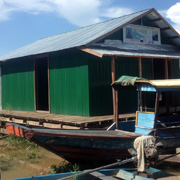
| In 2014, the EU-funded community fisheries conservation project in the Tonle Sap established a 65-hectare fish conservation zone, or community protected area (CPA), in Boeung Chhmar Ramsar site. Quarterly focus group discussions and monthly monitoring have shed light on both successes and challenges. |
 |
The main success has been the decline in illegal fishing in the CPA, which has resulted in increased fish catches during the high fishing season. Seven out of 10 villagers at a focus group discussion in July 2015 said that fish numbers have increased and only small-scale illegal fishing remains a problem in the CPA due to a greater public awareness of its livelihood benefits.
But if fish populations are to continue to recover, the new patrol plan needs to be strictly followed. The CPA committee, which manages the patrols, will be helped by a new floating guard post located inside the CPA, built at a cost of $4,000. This will not only give committee members a clear view of the CPA but it will also serve as an informal school for local children (the nearest school in Balot is 5 km away) and a community centre. This is an example of how the project looks for multi-purpose solutions that support both fish protection and broader community interests.
The main challenge is to be the threat of illegal blocking of fish migration channels connecting Boeung Chhmar and the Tonle Sap, which prevents fish recruitment to the CPA. This happened in September to December 2014 and it was only IUCN’s intervention that forced the local authorities to remove the nets. The local fishers are concerned that this could happen again and that without IUCN support they would be powerless to stop it.
At the July 2015 focus group discussion, the CPA committee again proposed that a study be carried out on the impacts of snakehead fish farming and the use of water hyacinth fish traps. These activities are technically illegal but are important for local livelihoods. To increase financial sustainability, the committee wants to charge fees from local and outside fishers who fish in the buffer or “spillover” zone of the CPA. In this way, outsiders can be transformed from a threat to an opportunity.
By Daniel Chadder (Internship Student from University of East Anglia (UEA), England and Sorn Pheakdey (Water and Wetlands Coordinator from IUCN).














Leave a Reply